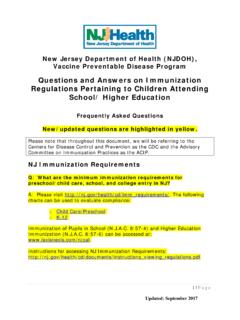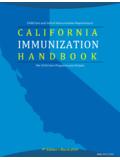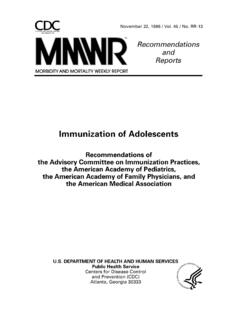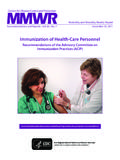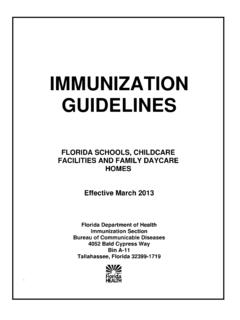Transcription of Manual on Expanded Program on Immunization
1 Manual on Expanded Program on Immunization Third Edition 2002. Department of Surveillance & Disease Control Directorate General of Health Affairs -1- E X P A N D E D P R O G R A M O N I M M U N I Z A T I O N. -2- 3. Edition DIRECTORATE GENERAL OF HEALTH AFFAIRS. Department of Surveillance & Disease Control Manual on Expanded Program on Immunization i E X P A N D E D P R O G R A M O N I M M U N I Z A T I O N. DEPARTMENT OF SURVEILLANCE & DISEASE CONTROL. Expanded Program on Immunization Ministry of Health, Sultanate of Oman Directorate General of Health Affairs PO Box 393, PC 113. Phone Fax Constructive suggestions for improving or updating this Manual would always be gratefully received. ii D E P A R T M E N T O F S U R V E I L L A N C E & D I S E A S E C O N T R O L. Contents Foreword i Contributors ii Contents iii Acronyms iv CHAPTER 1.
2 INRODUCTION. Global Scenario 1 CHAPTER 7. EPI Progress in Oman 1. EPI Policy Immunization SESSION 1. Strategy 2. Information to Mother 1. Objectives & Service Targets 2. Maintaining Cold Chain 3. Session CHAPTER 2 Opened Vial Policy Disposal of Sharps Immunization SCHEDULE 1 Golden Rules 3. Schedule 1. School Immunization 2 CHAPTER 8. TT Schedule 2. INJECTION SAFETY 1. CHAPTER 3 Introduction 1. Equipment Handling 3. ADVERSE EVENTS FOLLOWING Safe Disposals 3. Golden Rule 3. Immunization . Introduction 1 CHAPTER 9. AEFI Reporting 2. AEFI Monitoring 2 SUPERVISION 1. Objectives 1. CHAPTER 4 Targets for Supervision 3. Responsibilities 3. THE COLD CHAIN 1. Introduction 1 CHAPTER 10. Purpose 3. Storage Requirements 3 SCHOOL Immunization 1. Refrigeration Equipment Monitoring Tools Introduction 1.
3 Storage at EPI Units 3 Responsibilities 3. Schedule 3. CHAPTER 5. CHAPTER 11. STATIC UNITS 1. PRIVATE CLINICS 1. Introduction 1. Child Health Register 3 Introduction 1. Transfer of Responsibility 3 Vaccine Qualification 3. Feed Back Report Schedule 3. Children Born at Home Recording & Reporting Defaulter Retrieval Training EPI reporting 3 Supervision & Audit 3. CHAPTER 6 ANNEXURES. OUTREACH TEAMS 1 AEFI Case Investigation Form 4. Child Health Register MR374. Introduction 1 EPI Feed Back Report Form 4. Defaulter Retrieval 3 Vaccine Stock Form Inaccessible Population 3 Maintenance of Cold Chain Equipment Telephone & Fax Numbers Index 5. iii List of Contributors Chief Contributors Dr. Salah Al Awaidy Director, DSDC. Dr. Shyam Bawikar Epidemiologist, DSDC. Other Contributors Mr.
4 Islam Al Balushi National Supervisor, DSDC. Mr. Hussamuddin Nawar National Supervisor, DSDC. Mr. Bader Al Rawahi National Supervisor, DSDC. Mr. Salem Al Mahrooqi National Supervisor, DSDC. Reviewed by: Mr. Philips Duclose V&B, WHO, Geneva Dr. Saleh Al Khusaiby Sr. Consultant, Child Health Services Dr. Mohammed Al Hosni Consultant, Infectious Diseases, Royal Hospital Dr. Amr M. Taman Advisor, Quality Assurance, DGHA. Dr. M. V. Joseph National IMCI Coordinator, DGHA. iv D E P A R T M E N T O F S U R V E I L L A N C E & D I S E A S E C O N T R O L. Acronyms (A)AFB (Alcohol)-acid-fast bacilli AEFI Acute events following Immunization AFP Acute flaccid paralysis ARI Acute respiratory tract infections ATS Anti-tetanus serum (equine). BCG Bacille Calmette Guerin CSF Cerebrospinal fluid DGHA Directorate General of Health Affairs DPT Diphtheria, pertussis, tetanus DSDC Department of Surveillance & Disease Control DT Diphtheria, tetanus (child type).
5 DTaP Diphtheria, tetanus, acellular pertussis EHC Extended health centre EMRO WHO Regional Office for the Eastern Mediterranean EPI Expanded Programme on Immunization GBS Gullian Barre' syndrome HBsAg Hepatitis B surface antigen HBV Hepatitis B virus HC Health centre Hib Haemophilus influenzae type b HIV Human immunodeficiency virus ID Intradermal route IM Intramuscular route IPV Injectable poliomyelitis vaccine (killed). ISO International standards organization IU International units MCH Maternal and child health MMR Measles, Mumps, & Rubella vaccine MoD Ministry of Defence MoE Ministry of Education MoH Ministry of Health MOIC Medical officer in-charge MR Measles, Rubella vaccine NID National Immunization Day (Polio campaign). NWCCP National women and child care plan OPV Oral poliomyelitis vaccine PDO Petroleum development organization PHS Public health section ROP Royal Oman police RVS Regional vaccine stores SQU Sultan Qaboos University TIG Tetanus immune Globulin (human).
6 Td Tetanus-diphtheria [toxoid] adult type TT Tetanus toxoid UNICEF United Nations Children's Fund V&B Vaccine and Biologicals VPD Vaccine preventable diseases VQ Vaccine qualified (clinic). VVM Vaccine vial monitor WHO World Health Organization v E X P A N D E D P R O G R A M O N I M M U N I Z A T I O N. Forward EPI Program was one of the first health programme launched in Oman. In the last 30. years, Oman has transformed from an isolated undeveloped country to a modern welfare state. The dramatic decreases in mortality rates and other positive indicators of health and well-being, in conjunction with other political and economic transformations are due to the dedication and commitment of the Sultanate's leader, Sultan Qaboos. One of the most significant features is the dramatic drop in the infant mortality rate from around 125 per 1000 live births in the 1970's to less than per 1000 by the year 2001 and this can be attributed in part to the Expanded Programme on Immunization (EPI).
7 Childhood Immunization was one of the components of health services in Oman in the 1970's. But it was not until 1981 that the EPI Programme was launched with the establishment of an office and recruitment of staff for the programme. A. comprehensive childcare programme was launched nationally in 1987 and the child health card and child health register (MR2 register) was introduced. As a result, Immunization coverage increased throughout the late 1980's and early 1990's and coverage of more than 95% has been maintained since the early-1990's for all the vaccines in the EPI schedule. In the early 1990's there was a measles/rubella epidemic in which more than 3000. cases were reported. Most of those affected were children born before 1987 when Immunization coverage was comparatively low.
8 Due to this outbreak, a Measles-Rubella (MR) vaccination campaign was held to vaccinate all children between the ages of 15. months and 18 years. Subsequently, a second MR dose was introduced into the EPI. schedule. The EPI programme has now initiated the Hepatitis B campaign targeting all children not covered by the EPI programme. By the end of the Year 2004, everyone under the age of 20 years would have been vaccinated against Hepatitis B. Thus, the EPI schedule has been revised and Expanded several times over the past 20 years and now includes immunizations for 10 antigens; the latest was the introduction of the Hib vaccine this year. This Manual provides a comprehensive overview of the vaccines provided in the EPI. programme, the Immunization schedule, adverse-events-following- Immunization , the vaccine cold chain, and EPI disease surveillance follow-up and reporting.
9 It is hoped through this revised Standard Operating Procedures Manual all staff of the Ministry of Health and sister institutions will feel responsible for sustaining the universal acceptance by the community that Immunization is vital to the life, health and well-being of the children of this country and the resulting high Immunization coverage. Dr. Ali Jafer M. Suleiman Director General of Health Affairs Ministry of Health, Oman vi D E P A R T M E N T O F S U R V E I L L A N C E & D I S E A S E C O N T R O L. 1. Chapter Introduction Global Scenario W. orld Health Assembly in 1974 adopted a resolution and launched the Expanded Program on Immunisation (EPI). Since the 1980s, considerable progress in Immunization worldwide has helped to decrease mortality in young children.
10 As a result of Immunization almost 3 million lives have been saved each year, and 750,000 children are saved from disability. In 1999, the worldwide average vaccination coverage of children under five was 74%. One in every four children in the world remains without Immunization against the six diseases initially covered by EPI (Measles, Polio, Pertussis, Diphtheria, Tetanus and tuberculosis). Access to Immunization varies greatly across the world. A child in a developing country is ten times more likely to die of a vaccine-preventable disease than a child from an industrialized one. In some countries, up to 70% of children do not receive the full set of vaccines; the lowest coverage is found in sub-Saharan Africa. In Africa as a whole, over 40% of children are not immunized against Measles, a major cause of infant mortality that kills one child every minute.



